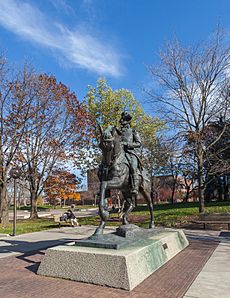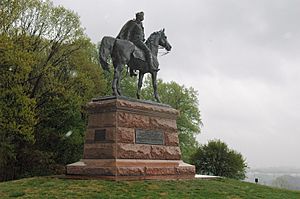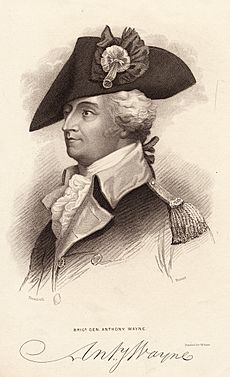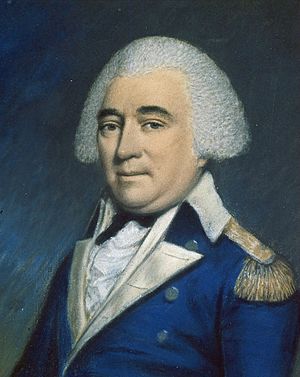Anthony Wayne facts for kids
Quick facts for kids
Anthony Wayne
|
|
|---|---|
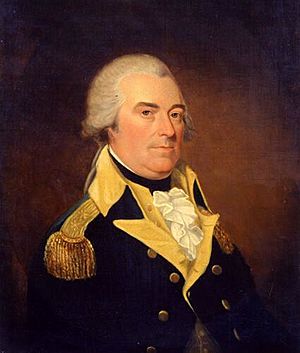 |
|
| 5th Senior Officer of the United States Army | |
| In office April 13, 1792 – December 15, 1796 |
|
| President | George Washington |
| Preceded by | Arthur St. Clair |
| Succeeded by | James Wilkinson |
| Member of the U.S. House of Representatives from Georgia's 1st district |
|
| In office March 4, 1791 – March 21, 1792 |
|
| Preceded by | James Jackson |
| Succeeded by | John Milledge |
| Personal details | |
| Born | January 1, 1745 Easttown Township, Province of Pennsylvania, British America |
| Died | December 15, 1796 (aged 51) Fort Presque Isle, Erie, Pennsylvania, U.S. |
| Resting place | Fort Presque Isle, Erie, Pennsylvania, U.S. and St. David's Episcopal Church, Radnor, U.S. |
| Political party | Anti-Administration party |
| Spouse | Mary Penrose |
| Children | Margretta Wayne Isaac Wayne |
| Relatives | Isaac Wayne (father) Samuel Van Leer (brother in-law) |
| Occupation | Soldier |
| Nickname | Mad Anthony |
| Military service | |
| Allegiance | |
| Branch/service | |
| Years of service | 1775–1783 1792–1796 |
| Rank | |
| Battles/wars | |
Anthony Wayne (born January 1, 1745 – died December 15, 1796) was an American soldier and leader. He was one of the Founding Fathers of the United States. He became a military officer at the start of the American Revolutionary War. His brave actions and strong personality earned him the nickname "Mad Anthony". Later, he led the U.S. Army on the frontier. He commanded the Legion of the United States.
Wayne was born in Chester County, Pennsylvania. He worked as a tanner and surveyor. He also attended the College of Philadelphia. In 1775, he helped create a Pennsylvania militia unit. During the Revolutionary War, he fought in several important battles. These included the Invasion of Quebec and the Philadelphia campaign. He also fought in the Yorktown campaign.
After the war, Wayne lived in Georgia. He briefly served in the United States House of Representatives. Later, he returned to the Army. He led U.S. forces in the Northwest Indian War. He defeated an alliance of Native American tribes. This alliance was called the Northwestern Confederacy. After his victory, he helped negotiate the Treaty of Greenville. This treaty ended the war.
Wayne's actions against Native Americans and his ownership of slaves have made his legacy controversial.
Contents
Early Life and First Steps in Politics
Anthony Wayne was one of four children. His father, Isaac Wayne, came to Pennsylvania from Ireland. Anthony was born on January 1, 1745, on his family's large estate. His father wanted him to be a farmer. But young Anthony was more interested in military stories. His father was a captain during the French and Indian War. This left a big impression on Anthony.
He studied to become a surveyor. He went to his uncle's academy and the College of Philadelphia. In 1765, Benjamin Franklin sent him to Nova Scotia. He helped survey land and start a new settlement there.
In 1766, he married Mary Penrose. They had two children, Margretta and Isaac. Wayne also owned a slave named Toby. In 1774, Wayne became involved in politics. He was elected chairman of the Chester County Committee of Safety. Then he was elected to the Pennsylvania Provincial Assembly.
Fighting for American Independence
In 1775, Wayne joined the Pennsylvania Committee of Safety. He began to oppose the British. In January 1776, he became a colonel in the 4th Pennsylvania Regiment. He believed in strong discipline and new fighting methods. He did not always use traditional battle lines.
Wayne and his regiment joined the Continental Army. They were part of the invasion of Canada. He led a successful retreat at the Battle of Trois-Rivières. He also commanded forces at Fort Ticonderoga. Because of his service, he was promoted to brigadier general in 1777.
The "Mad Anthony" Nickname
Historians say Wayne earned the name "Mad Anthony" because of his strong temper. One story tells of him severely punishing an informant. This showed his fierce and determined nature.
Key Revolutionary War Battles
On September 11, 1777, Wayne led the Pennsylvania Line at the Battle of Brandywine. They fought bravely to protect the American forces. Later, his camp was attacked at the Battle of Paoli. The British used bayonets to keep their attack secret. Wayne's reputation suffered from the losses. He asked for an official investigation to clear his name.
On October 4, 1777, Wayne fought in the Battle of Germantown. His soldiers pushed ahead too quickly. They became trapped and had to retreat. Wayne was again ordered to protect the retreating army.
After spending winter at Valley Forge, Wayne led an attack at the 1778 Battle of Monmouth. His forces were left alone by another general. They were outnumbered by the British. But Wayne held his ground until help arrived. He then continued to fight.
Wayne also showed how to deal with tough conditions. In 1778, he wrote about the harsh cold and lack of supplies. He worked hard to keep his soldiers "well and comfortable."
Stony Point Victory
In July 1779, George Washington put Wayne in charge of a special unit. This unit was called the Corps of Light Infantry. Wayne's most famous moment in the war was his attack on Battle of Stony Point. On July 16, 1779, he led a nighttime bayonet attack. His 1,500 soldiers captured British forts at Stony Point. This was a cliff-side fort on the Hudson River.
The battle lasted only 30 minutes. Wayne's forces took about 550 prisoners. They had fewer than 100 casualties. Wayne himself was wounded during the attack. This victory boosted the army's morale. The Continental Congress gave him a medal for his success.
In 1780, Wayne led troops to attack a British blockhouse at Bulls Ferry. His troops could not capture the position. They suffered 64 casualties.
Mutiny and Southern Campaigns
In January 1781, Wayne was commanding officer of the Pennsylvania Line. Soldiers were unhappy about their pay and conditions. This led to the Pennsylvania Line Mutiny. Wayne successfully ended the mutiny. He dismissed about half the soldiers. He then brought the Pennsylvania Line back to full strength.
Later, he went to Virginia to help Lafayette fight the British. In July 1781, Wayne led a scouting force at the Battle of Green Spring. They fell into a trap set by General Charles Cornwallis. Only a brave bayonet charge allowed his forces to retreat. This action reinforced his "Mad Anthony" nickname. During the Yorktown campaign, Wayne was shot in the leg. The musket ball was never removed.
After the British surrendered at Yorktown, Wayne went south to Georgia. He worked to end the British alliance with Native American tribes. He captured some Creek troops and released them. He hoped to build good relations. But after more fighting, he became angry. In one case, he executed thirty Creek people he captured. He then negotiated peace treaties with the Creeks and Cherokees. For this, Georgia gave him a rice plantation. He suffered from malaria for the rest of his life.
Life After the War
In 1783, Wayne returned to Pennsylvania as a hero. He decided to enter politics. He believed the United States should have a strong central government. He joined the Federalist Party. He was elected to the Pennsylvania General Assembly for two years.
Challenges in Georgia
Wayne moved to Georgia to run two large rice plantations. He mortgaged his family home to buy 47 slaves. He used a plantation overseer to manage his slaves. Wayne quickly fell into debt. His plantations were not successful. He had to sell his slaves and property.
During this time, his wife left him. Wayne became a citizen of Georgia in 1788.
Time in Congress
In 1790, Wayne was elected to the 2nd United States Congress. He represented Georgia's 1st congressional district. However, his opponent, James Jackson, accused him of electoral fraud. This means there were unfair practices in the election. A House committee found that fraud had happened. Congress voted Wayne out of office in March 1792. He did not run for re-election. Wayne was now bankrupt and out of office.
Leading the Legion of the United States
The Northwest Indian War was a difficult time for the United States. The British still held forts in the region. They also supported Native American tribes. These tribes wanted the Ohio River to be the border with the U.S. Native Americans had won major victories against U.S. forces. The most famous was St. Clair's defeat. This was the biggest defeat ever by Native Americans against the American military.
President Washington needed a strong leader. He called Wayne back to military service. Wayne was injured and suffered from malaria. But he accepted command of the new Legion of the United States in 1792. Washington gave Wayne a large budget. Wayne's job was to gain control of the Northwest Territory. He was ordered to battle Native Americans. He was also told to destroy their villages and food supplies. This would make them weaker in winter.
Training the Legion
Wayne knew his new command would be tough. His first task was to recruit more soldiers. He started in Pittsburgh, Pennsylvania. It was hard to find new soldiers because of past failures. But Wayne eventually built up the Legion.
He set up Legionville as a basic training facility. This was the first time the U.S. Army had a special place for training recruits. Wayne used a book called Regulations for the Order and Discipline of the Troops of the United States to train his soldiers. He was a strict disciplinarian. He even executed soldiers for serious offenses. He wanted his soldiers to be professional and well-trained.
Wayne shared the hardships with his men. He made sure they were disciplined and instructed. He also allowed them a small amount of whiskey with their rations. He gave extra to the best shooters. This helped build confidence among his troops.
Campaigns in Ohio
In December 1793, Wayne sent troops to Ohio. They built Fort Recovery at the site of St. Clair's defeat. This became a base for operations. In 1794, Native American forces attacked Fort Recovery. But they failed to capture it. In response, the British built Fort Miami to block Wayne's advance.
Wayne's army continued north. They built defensive forts along the way. On August 20, 1794, Wayne attacked the Native American confederacy. This was the Battle of Fallen Timbers near modern Maumee, Ohio. It was a decisive victory for the U.S. forces. This battle effectively ended the war.
After the battle, Wayne used Fort Defiance as a base. He ordered his troops to destroy Native American crops, homes, and villages. This was done within a 50-mile radius. This was a "scorched earth" tactic. It aimed to make the Native Americans unable to continue fighting.
Native American troops tried to find safety at the British Fort Miami. But they were locked out. Wayne then camped near Fort Miami. He destroyed more Native American villages in sight of the fort. He tried to provoke the British commander. But neither side wanted to start another war.
Wayne then moved to Kekionga, the Miami capital. He destroyed it and built a new fort there. This was Fort Wayne. It was a strong fort, built to withstand attacks.
Treaty of Greenville
Wayne then negotiated the Treaty of Greenville. This treaty was signed on August 3, 1795. It gave most of Ohio to the United States. This cleared the way for Ohio to become a state. Wayne's victory was a turning point. It helped lead to the westward expansion of the U.S.
Wilkinson's Betrayal
Wayne's second-in-command was General James Wilkinson. Wilkinson secretly tried to undermine Wayne. He wrote negative letters about Wayne to newspapers and politicians. Wilkinson was also a spy for Spain. He tried to delay supplies to Wayne's army.
Secretary of War Henry Knox told Wayne about Wilkinson. Wayne started an investigation. He found proof that Wilkinson was a spy. Wayne planned to put Wilkinson on trial. However, Wayne became ill and died before the trial could happen. Wilkinson then became the Senior Officer of the Army.
Death and Legacy
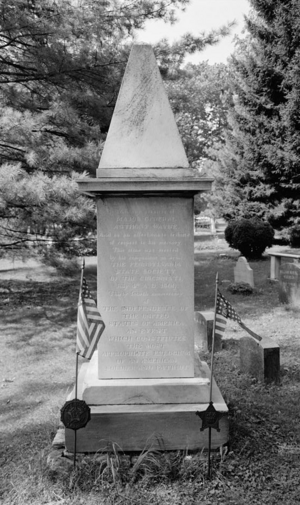
Anthony Wayne died on December 15, 1796. He was on his way back to Pennsylvania from Detroit. He was buried at Fort Presque Isle. Later, his son moved most of his remains to a family plot in Pennsylvania.
Wayne is remembered as a brave battle tactician. He was known for being impulsive and aggressive. President Theodore Roosevelt later called Wayne America's best fighting general.
More recently, Wayne's legacy has been criticized. This is because of his actions against Native Americans. His military leadership led to the forced removal of Native Americans from the Ohio Valley. Historians have described his beliefs as showing "racial and cultural chauvinism". His victory in the Northwest Indian War set a pattern for how the U.S. government treated Native Americans. Some Native American groups believe that celebrating Wayne ignores his role in their displacement.
In 2019, the city council in Fort Wayne, Indiana, voted to approve Anthony Wayne Day. This decision caused debate. Some people felt it ignored the negative impact of Wayne's actions on Native Americans.
Wayne is also remembered for other issues. He had relationships with other women. This led to his wife leaving him. He also owned slaves and used them on his plantations. He viewed his slaves as property. He later sold them. Also, he and his campaign manager were involved in election fraud. This led to Wayne being removed from Congress.
The Third United States Infantry was formed in 1792. It helped Wayne win the Northwest Indian War. Today, the Third Regiment is famous for its role at the Tomb of the Unknown Soldier.
Memorials
A painting by Constantino Brumidi in the United States Senate building shows Wayne wounded at Stony Point. In 1929, the U.S. Post Office issued a stamp honoring Wayne. It marked the 135th anniversary of the Battle of Fallen Timbers. The stamp shows the Battle of Fallen Timbers Monument.
Descendants and Relatives
Some of Wayne's notable relatives include:
- Isaac Wayne (1772–1852), Wayne's son, who was a member of the U.S. House of Representatives.
- Captain William Evans Wayne (1828-1901), who fought for the Union in the American Civil War.
- Blake Wayne Van Leer (1926-1997), a commander in the U.S. Navy.
Images for kids
-
The Storming of Stony Point, 1779 by Constantino Brumidi (1871) in room S-128 of the United States Capitol
-
Battle of Fallen Timbers, commemorative issue of 1928, 2¢
-
His home, Waynesborough in Paoli, Pennsylvania
-
Keystone Marker in Wayne, Pennsylvania, named for General Wayne
-
Wayne County Building (Detroit, Michigan) pediment
See also


